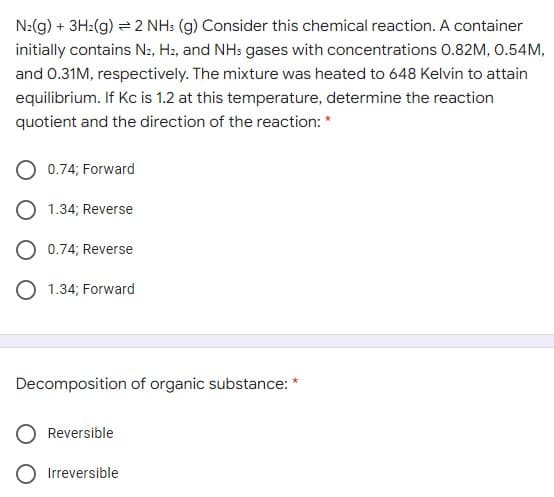N:(g) + 3H:(g) = 2 NH: (g) Consider this chemical reaction. A container initially contains N2, H2, and NH: gases with concentrations 0.82M, 0.54M, and 0.31M, respectively. The mixture was heated to 648 Kelvin to attain equilibrium. If Kc is 1.2 at this temperature, determine the reaction quotient and the direction of the reaction: * O 0.74; Forward O 1.34; Reverse O 0.74; Reverse O 1.34; Forward Decomposition of organic substance: * Reversible
N:(g) + 3H:(g) = 2 NH: (g) Consider this chemical reaction. A container initially contains N2, H2, and NH: gases with concentrations 0.82M, 0.54M, and 0.31M, respectively. The mixture was heated to 648 Kelvin to attain equilibrium. If Kc is 1.2 at this temperature, determine the reaction quotient and the direction of the reaction: * O 0.74; Forward O 1.34; Reverse O 0.74; Reverse O 1.34; Forward Decomposition of organic substance: * Reversible
Chemistry & Chemical Reactivity
9th Edition
ISBN:9781133949640
Author:John C. Kotz, Paul M. Treichel, John Townsend, David Treichel
Publisher:John C. Kotz, Paul M. Treichel, John Townsend, David Treichel
Chapter15: Principles Of Chemical Reactivity: Equilibria
Section: Chapter Questions
Problem 38GQ: At 2300 K the equilibrium constant for the formation of NO(g) is 1.7 103. N2(g) + O2(g) 2 NO(g)...
Related questions
Question
Please answer all (11)

Transcribed Image Text:N2(g) + 3H2(g) = 2 NH: (g) Consider this chemical reaction. A container
initially contains N2, H2, and NH: gases with concentrations 0.82M, 0.54M,
and 0.31M, respectively. The mixture was heated to 648 Kelvin to attain
equilibrium. If Kc is 1.2 at this temperature, determine the reaction
quotient and the direction of the reaction: *
O 0.74; Forward
O 1.34; Reverse
O 0.74; Reverse
O 1.34; Forward
Decomposition of organic substance: *
Reversible
O Irreversible
Expert Solution
This question has been solved!
Explore an expertly crafted, step-by-step solution for a thorough understanding of key concepts.
Step by step
Solved in 2 steps

Knowledge Booster
Learn more about
Need a deep-dive on the concept behind this application? Look no further. Learn more about this topic, chemistry and related others by exploring similar questions and additional content below.Recommended textbooks for you

Chemistry & Chemical Reactivity
Chemistry
ISBN:
9781133949640
Author:
John C. Kotz, Paul M. Treichel, John Townsend, David Treichel
Publisher:
Cengage Learning

Chemistry & Chemical Reactivity
Chemistry
ISBN:
9781337399074
Author:
John C. Kotz, Paul M. Treichel, John Townsend, David Treichel
Publisher:
Cengage Learning

Chemistry: The Molecular Science
Chemistry
ISBN:
9781285199047
Author:
John W. Moore, Conrad L. Stanitski
Publisher:
Cengage Learning

Chemistry & Chemical Reactivity
Chemistry
ISBN:
9781133949640
Author:
John C. Kotz, Paul M. Treichel, John Townsend, David Treichel
Publisher:
Cengage Learning

Chemistry & Chemical Reactivity
Chemistry
ISBN:
9781337399074
Author:
John C. Kotz, Paul M. Treichel, John Townsend, David Treichel
Publisher:
Cengage Learning

Chemistry: The Molecular Science
Chemistry
ISBN:
9781285199047
Author:
John W. Moore, Conrad L. Stanitski
Publisher:
Cengage Learning

Chemistry
Chemistry
ISBN:
9781305957404
Author:
Steven S. Zumdahl, Susan A. Zumdahl, Donald J. DeCoste
Publisher:
Cengage Learning

Chemistry: An Atoms First Approach
Chemistry
ISBN:
9781305079243
Author:
Steven S. Zumdahl, Susan A. Zumdahl
Publisher:
Cengage Learning
